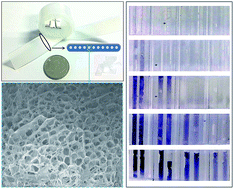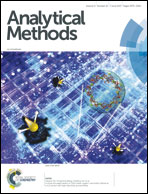Determination of hydrogen peroxide using novel test strips based on plastic microcapillary film
Abstract
This work proposes a novel method for the semi-quantitative determination of hydrogen peroxide (H2O2) in routine applications. Potassium iodide (KI) and starch are adopted as chromogenic reagents, while microcapillary films (MCFs) are employed as the reaction platform. An innovative loading method, including filling, gelatinization, and freeze-drying of reagents, is established to create a solid porous medium inside the MCF matrix for immobilizing the reagents. The porous medium has sufficient specific surface area and rapid rehydration for reaction detection. To verify the feasibility of this new method, two kinds of test strips were fabricated in the present investigation: a colorimetric strip and four-section grading test strip. Results showed that the standard colorimetric strip could detect H2O2 residue with concentrations of 0.02–0.1 wt% with a testing time of 120 s. Meanwhile, using the four-section grading test strip, the H2O2 residue concentration was determined simply by counting the number of colored sections with the naked eye. H2O2 concentrations of 0–0.12 wt% were divided into five grades by the grading test strips, with a testing time of 45 s. Compared with traditional colorimetric methods, this grading method provides a more intuitive and understandable result for users. Furthermore, it provides a new way to involve people suffering from color weakness or blindness in the relevant research community.



 Please wait while we load your content...
Please wait while we load your content...